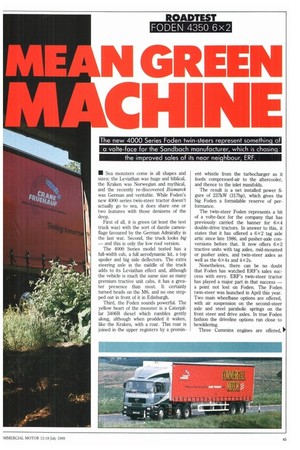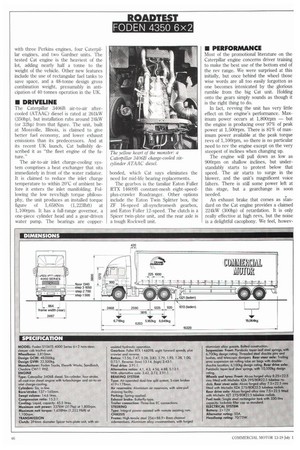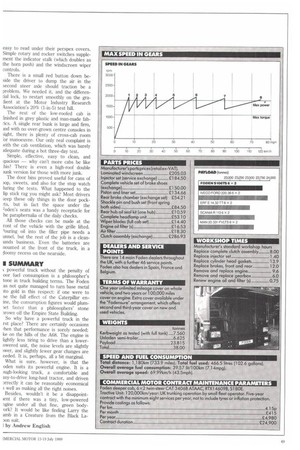N GR EEN
Page 47

Page 48

Page 49

Page 50

Page 51

If you've noticed an error in this article please click here to report it so we can fix it.
4111 !WI
The new 4000 Series Foden twin-steers re.resent somethin• of a volte-face for the Sandbach manufacturer, which is chasm the im•roved sales of its near nei•hbour, ERF.
• Sea monsters come in all shapes and sizes; the Leviathan was huge and biblical, the Kraken was Norwegian and mythical, and the recently re-discovered Bismarck was German and veritable. While Foden's new 4000 series twin-steer tractor doesn't actually go to sea, it does share one or two features with those denizens of the deep.
First of all, it is green (at least the test truck was) with the sort of dazzle camouflage favoured by the German Admiralty in the last war. Second, the truck looks big — and this is only the low roof version.
The 4000 Series model tested has a full-width cab, a full aerodynamic kit, a top spoiler and big side deflectors. The extra steering axle in the middle of the truck adds to its Leviathan effect and, although the vehicle is much the same size as many premium tractive unit cabs, it has a greater presence than most. It certainly turned heads on the M6, and no one stepped out in front of it in Edinburgh.
Third, the Foden sounds powerful. The yellow heart of the monster is a Caterpillar 3406B diesel which rumbles gently along, although when prodded it wakes, like the Kraken, with a roar. This roar is joined in the upper registers by a promin
ent whistle from the turbocharger as it feeds compressed-air to the aftercooler, and thence to the inlet manifolds.
The result is a net installed power figure of 237kW (317hp), which gives the big Foden a formidable reserve of performance.
The twin-steer Foden represents a bit of a volte-face for the company that has previously carried the banner for 6X4 double-drive tractors. In answer to this, it states that it has offered a 6x2 tag axle artic since late 1986, and pusher-axle conversions before that. It now offers 6x2 tractive units with tag axles, mid-mounted or pusher axles, and twin-steer axles as well as the 6x4s and 4x 2s.
Nonetheless, there can be no doubt that Foden has watched ERF's sales success with envy. ERF's twin-steer tractor has played a major part in that success — a point not lost on Foden. The Foden twin-steer was launched in April this year. Two main wheelbase options are offered, with air suspension on the second-steer axle and steel parabolic springs on the front steer and drive axles. In true Foden fashion the driveline options run close to bewildering.
Three Cummins engines are offered, with three Perkins engines, four Caterpillar engines, and two Gardner units. The tested Cat engine is the heaviest of the lot, adding nearly half a tonne to the weight of the vehicle. Other new features include the use of rectangular fuel tanks to save space, and a 48-tonne design gross combination weight, presumably in anticipation of 40 tonnes operation in the UK.
• DRIVEUNE
The Caterpillar 3406B air-to-air aftercooled (ATAAC) diesel is rated at 261kW (350hp), but installation rubs around 24kW (or 32hp) from that figure. The unit, built at Mossville, Illinois, is claimed to give better fuel economy, and lower exhaust emissions than its predecessors. And at its recent UK launch, Cat bullishly described it as "the fleet engine of the future."
The air-to-air inlet charge-cooling system comprises a heat exchanger that sits immediately in front of the water radiator. It is claimed to reduce the inlet charge temperature to within 20°C of ambient before it enters the inlet manifolding. Following the low revs/high torque philosophy, the unit produces an installed torque figure of 1,658Nm (1,2231bft) at 1,100rpm. It has a full-range governor, a one-piece cylinder head and a gear-driven water pump. The bearings are copper bonded, which Cat says eliminates the need for mid-life bearing replacements.
The gearbox is the familiar Eaton Fuller RTX 14609B constant-mesh eight-speedplus-crawler Roadranger. Other options include the Eaton Twin Splitter box, the ZF 16-speed all-synchromesh gearbox, and Eaton Fuller 12-speed. The dutch is a Spicer twin-plate unit, and the rear axle is a tough Rockwell unit.
• PERFORMANCE
Most of the promotional literature on the Caterpillar engine concerns driver training to make the best use of the bottom end of the rev range. We were surprised at this initially, but once behind the wheel those wise words are all too easily forgotten as one becomes intoxicated by the glorious rumble from the big Cat unit. Holding onto the gears simply sounds as though it is the right thing to do.
In fact, revving the unit has very little effect on the engine's performance. Maximum power occurs at 1,800rpm — but the engine is producing over 97% of peak power at 1,500rpm. There is 81% of maximum power available at the peak torque revs of 1,100rpm, so there is no particular need to rev the engine except on the very steepest of inclines when changing up.
The engine will pull down as low as 900rpm on shallow inclines, but understandably starts to protest below that speed. The air starts to surge in the blower, and the unit's magnificent voice falters. There is still some power left at this stage, but a gearchange is soon needed. An exhaust brake that comes as standard on the Cat engine provides a claimed 224kW (300hp) of retardation. It is only really effective at high revs, but the noise is a delightful cacophony, We feel, howev er, it could be made quieter for the UK's urban environment.
One aspect of the engine, which is somewhat overstated by the manufacturer but nevertheless useful, is the governor. This allows the driver to keep a steady accelerator pedal while the governor adjusts the fuel flow to maintain the engine speed up hill and down dale. The governor also raises the engine speed when starting off so that the truck will move away without stalling with no need to touch the accelerator pedal. Caterpillar think that this is of use in almost all conditions: we decided it wasn't. The spring brake delay when letting off the park brake, or a slight incline is too much for the governor to cope with, and the truck stalls. However, this feature is useful for shunting in a yard or difficult reversing.
Travelling round our Scottish test route, we wondered whether this engine would not be better suited by an Eaton Twin Splitter gearbox in place of the constant-mesh nine-speed Roadranger fitted. It would certainly make the driver's life easier, but the simplicity of changing down a third of a gear on the slightest incline might discourage a driver from making full use of the Cat engine's lugging potential in the interest of a less labouring engine note.
As it is, the eight forward speeds and crawler are well suited to the Cat engine's power. Eighth gear can be used in most circumstances except 48km/h (30mph) speed limits or more than slight inclines. While the gears are well spaced, we still had to change down two gears on the steeper sections of the A68. The cable linkage (derived from aeronautical technology) helped rather than hindered those changes, and steady progress was maintained on all our test hills including the infamous Black Hill, where the engine even managed to support two upchanges.
• ECONOMY
Foden tractors have never set the CM world alight with their frugality round the Scottish heavy truck test route. Our first 6x4 Super E400 Cumminspowered 4000 Series Foden tractor (CM 10-16 September 1987) returned a disappointing 45.61it/100km (6.20mpg) albeit at a cracking overall speed of 73.6km/h (45.8mph).
Owners tend to buy Fodens for reasons other than mere fuel economy (not least the kerbweight), so it may come as a shock to learn that this Foden has fared rather well in comparison with the competition in the economy stakes. Weather conditions were fine on the test route, although there was a northerly headwind on the first day's haul up to Gretna. Despite the heat and headwind of the first day, the air-to-air after-cooling of the Cat lump, and the truck's aerodynamics helped it turn in 37.11it/100km (7.6mpg) between Burton services and Gretna, and an even better 39.57lit/100km (7.14mpg) over the route as a whole.
Our comparison vehicles are a mixed bunch of 6X2 tractors, and it is interesting to note that the Foden has a better fuel consumption than the MAN 20.331 with 243kW (324hp), or the Leyland Daf 20.35 with 240kW (322hp), tested in 1987 (CM 23-29 July 1987). The 1veco Ford 220.36 with 256kW (360hp) did better. as did the ERF E14.32TT with 224kW (301hp). The new Scania R113 6x2, however, was only marginally better at 39.2lit/100km (7.2mpg) with its 260kW (354hp) engine. If you're looking for maximum twin-steer economy, however, then the Foden is noticably behind the lowerpowered Leyland Dar 95.310 6x2 (CM 6-12 October 1988) which returned 37.3lit/100km (7.58mpg) at a faster overall average speed of 71.31un/h (44.3mph).
III PAYLOAD
Our test trailers have become heavier since they have been converted to air suspension, so the figures in our comparison charts have been adjusted to allow for the heavier test trailer. After adjustment, the Foden's 23.815-tonne payload shows up well against the opposition, with only the Leyland Daf 20.35 6x2 doing better at 23.985 tonnes.
This would be unsurprising were it not for the extra weight of the Caterpillar engine. After all, the Foden is equipped with aluminium chassis crossmembers, aluminium wheels, glass-reinforced-plastic or the ubiquitous aluminium bodywork — even the catwalk is a lightweight. With a smaller Cummins L10 engine, the Foden would show all the opposition the way home, in payload terms at least.
• HANDLING
While the extra steering axle certainly gives the Foden a better ride than a steelsprung 4 x2 tractor, it is still bumpy. The first steering axle rides over a pothole well, but the second steer and drive axles can be clearly felt going over the bumps.
We also discovered that the wheels tend to dance over the bumps in the road when braking and turning on hills. This leads to an uncertainty in the steering as different tyres, on different axles, with different deflections, take the steering effort of the truck and alter the effective turning radius. The truck will always make the turn, but the steering feels peculiar.
The axles also thumped up and down strongly in our braking tests. This increased the braking distances, although to be fair the tnick did pull up a straight line, even from 64kmfh (40mph). On reflection, all three faults could he the result of inadequate damping on the axles, which shouldn't be too hard to solve.
• CAB COMFORT
The imposing air deflector on top of the cab left only 300mm of the front of our test trailer exposed to the ravages of squadrons of flies and mosquitoes. The close-coupled trailer also reduced the drag, and the side skirts only served to confirm the impression of a square rigger after months at sea.
Inside, however, the conditions are anything but "below decks". The only reminder of the sea was the slimy feel of the steering wheel after copious applications of silicon spray cleaner. A basicblack dashboard is angled slightly towards the driver on the left to bring some of the switches within reach of those short-inthe-arms midshipmen.
The instruments are comprehensive and easy to read under their perspex covers. Simple rotary and rocker switches supplement the indicator stalk (which doubles as the horn push) and the windscreen wiper controls.
There is a small red button down beside the driver to dump the air in the second steer axle should traction be a problem. We needed it, and the differential lock, to restart smoothly on the gralent at the Motor Industry Research Association's 20% (1-in-5) test hill.
The rest of the low-roofed cab is anished in grey plastic and man-made fabrics. A single rear bunk is large and firm, Ind with no over-grown centre consoles in sight, there is plenty of cross-cab room or manoeuvre. Our only real complaint is Nith the cab ventilation, which was barely sdequate during a hot three-day test.
Simple, effective, easy to clean, and spacious — why can't more cabs be like his? There is even a high-roof double Rink version for those with more junk. The door bins proved useful for cans of )op, sweets, and also for the stop watch luring the tests. What happened to the lip stick rag you might ask? Most drivers keep these oily things in the door pockAs, but in fact the space under the ?oden's seats was a handy receptacle for he paraphernalia of the daily checks.
All those checks can be made at the rant of the vehicle with the grille lifted. 'ouring oil into the filler pipe needs a unnel, but the rest of the job is a cleanlands business. Even the batteries are flaunted at the front of the truck, in a ;loomy recess on the nearside.
I SUMMARY
powerful truck without the penalty al ,00r fuel consumption is a philosopher's tone in truck building terms. The Foden as not quite managed to turn base metal to gold in this respect: if one were to se the full effect of the Caterpillar enme, the the consumption figures would plumlet faster than a philosophers' stone nrown off the Empire State Building.
So why have a powerful truck in the rst place? There are certainly occasions then that performance is sorely needed; ke on the hills of the A68. The engine is lightly less tiring to drive than a lowerowered unit, the noise levels are slightly ower, and slightly fewer gear changes are ceded. It is, perhaps, all a bit marginal. What is sure, however, is that the oden suits its powerful engine. It is a nigh-looking truck, a comfortable and asy-to-drive long-haul tractor, and driven xrectly it can be reasonably economical 3 well as making all the right noises.
Besides, wouldn't it be a disappointlent if there was a tiny, low-powered ngine under all that fine, green bodyark? It would be like finding Larry the amb in a Creature from the Black La)on suit.
I by Andrew English








































































































































